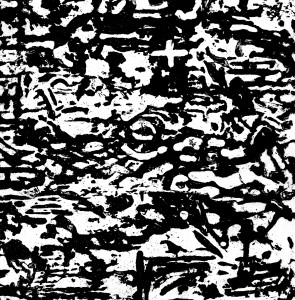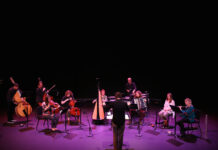In the 1972 essay “A Compositional Problem,” Morton Feldman mentioned a contradiction he felt faced him as a composer: The contradiction between instrumental color and the immediacy of sound. For a composer with a deep belief in not pushing sounds around—as he often asserted—resolving or overcoming this contradiction would seem to be a matter of some importance. Clarinet and String Quartet, a late, single-movement work in which the identities of strings and reed are often brought to the point of erasure, seem to resolve the contradiction by reimagining timbre as the neither/nor effusion of an instrument without qualities.
Clarinet and String Quartet (1983) was written for clarinetist Alan Hacker. It was written at a time when, as Feldman declared, he was interested in composing pieces that were difficult—not only for audiences, but for the performers who would realize them. Part of the difficulty was in herent in the extended lengths of many of these pieces, and in the technical demands their call for restrained overall dynamics placed on the performers. Clarinet and String Quartet is typical of Feldman’s late works in that regard: It runs for approximately 45 minutes, all of it at a low, virtually unvarying volume. Difficult doesn’t mean impossible, though, as the piece has been recorded several times, by clarinetists Ib Hausmann, Roger Heaton, Mark Lieb, and Carol Robinson. On Important Records/Saltern’s fine new recording the work is realized by clarinetist Anthony Burr with violinists Graeme Jennings and Gascia Ouzounian, violist Che-Ye Chen and cellist Charles Curtis.
As with much of Feldman’s late work, Clarinet and String Quartet builds long form out of a paucity of materials. Feldman accomplishes this by taking brief motivic cells and scaling them up to larger forms through repetition and microvariations. These motivic cells are organized around the four-note chromatic set B-C-A-Bb, which undergoes incremental mutations as it is repeated throughout the length of the work. This process of building macro structures through patterned micro variations, which Feldman referred to as “crippled symmetry,” entails a kind of musical argument from imperfect identity—that is, the perpetuation of a pattern through inexactly reproduced iterations. Combined with the piece’s long duration—the Saltern realization is over 47 minutes long—the imperfect identity of the recurring patterns as they appear, disappear and evolve over the course of the work were meant to challenge the listener’s sense of recollection. Engaging memory in this way—“alienating” it, to use Feldman’s term—was a deliberate goal of the later compositions. But there’s as much gratification to be had in simply enjoying local events individually. The five voices frequently combine into subtly jarring chords that lead and follow each other without pointing toward any defined harmonic goal. The piece moves forward without appearing to go anywhere; in place of identifiable melodies or harmonic progressions, clarinet and string quartet together weave a slowly shifting, richly dissonant texture.
Texture in fact is the focus of much of this music. While most conventional music tends to be organized as a gestalt of figure and field—as a set of foreground elements playing out against a background—Clarinet and String Quartet, like much of Feldman’s late music, is virtually all field. The clarinet occasionally states what in the context of the piece could be called a melody, but more often than not it fuses with the strings into a chordal collective, serving to displace harmonies rather than to stand out as a distinctive solo voice in its own right. This fusion of voices may well have been Feldman’s solution to the problem he saw of instrumental timbre overdetermining and thereby compromising sound in itself. With Clarinet and String Quartet he managed to create a work that, in clarinetist Carol Robinson’s apt description, discloses itself through a “merge[d]…hybrid timbre.” Timbre is still a significant element in the piece—it would seem to be unavoidable in any kind of work based on sound—but it is transformed into something that doesn’t reduce to definition in terms of a readily recognizable—and hence too noticeably mediating—voice. It is a timbre of neither/nor—neither this specific instrument nor that.
With its smooth integration of all five voices, the Saltern recording conveys Feldman’s hybrid timbre quite effectively. The musicians draw from a suitably muted palette and produce the subtle shadings of intonation elicited by Feldman’s enharmonic writing for the different parts. The occasional instances where the parts diverge—through rhythmic variation or the strings’ subtly disruptive pizzicato passages—only serve to reinforce the overall sense that the work has been performed on a single instrument of uncertain provenance.
Thus what appeared to Feldman in 1972 to be a warning concerning his composition—that it was at least potentially subject to a dichotomy rooted in “the strange resistance of the sounds themselves to taking on an instrumental identity”—could be taken as the prefiguration of a compositional strategy pointing the way out. This strategy, as embodied in Clarinet and String Quartet’s hybrid timbre, calls for nothing less than the dissolution of instrumental identity through a combination of orchestration and the reduction of the composition’s gestalt to the field.







